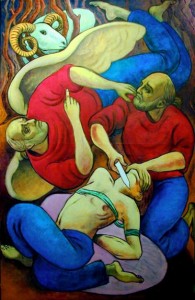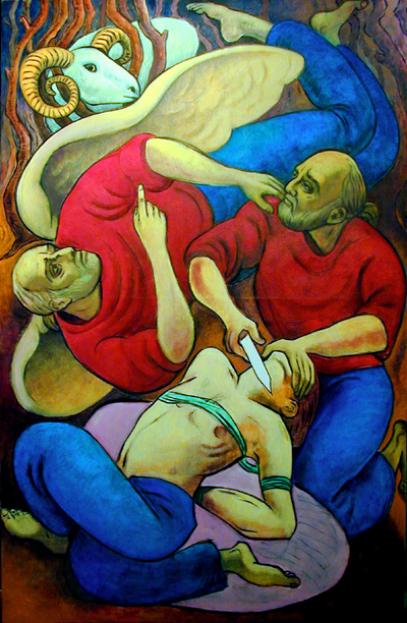 In this episode, members of the Mormon Matters “Genesis Team”—David Bokovoy, Tom Roberts, and Brian Hauglid—discuss and give textual and theological analyses of the Genesis and Book of Abraham accounts of the great patriarch Abraham. Where do the texts differ? Are there resources from ancient studies or the wider Judeo-Christian literature that bolster some of the Book of Abraham’s distinctive points? Why did Abraham flee Ur? What was the episode in Egypt all about when Abraham told Sarai to say she was his sister rather than his wife? The members of the team also discuss the “Abrahamic Covenant” as well as Hagar and Ishmael, helping us better understand their histories and continued impact. Finally, they take on the Akedah, the “binding of Isaac,” in all its difficulty. Is there a theologically satisfying way to discuss this difficult story?
In this episode, members of the Mormon Matters “Genesis Team”—David Bokovoy, Tom Roberts, and Brian Hauglid—discuss and give textual and theological analyses of the Genesis and Book of Abraham accounts of the great patriarch Abraham. Where do the texts differ? Are there resources from ancient studies or the wider Judeo-Christian literature that bolster some of the Book of Abraham’s distinctive points? Why did Abraham flee Ur? What was the episode in Egypt all about when Abraham told Sarai to say she was his sister rather than his wife? The members of the team also discuss the “Abrahamic Covenant” as well as Hagar and Ishmael, helping us better understand their histories and continued impact. Finally, they take on the Akedah, the “binding of Isaac,” in all its difficulty. Is there a theologically satisfying way to discuss this difficult story?
Please listen and then share your comments below!
Correction: Early in the episode, Tom gave the wrong name for a website where academics share their work. The site he is referring to is http://www.academia.edu/.
Links:
David Bokovoy, Authoring the Old Testament (Kofford Books, 2014)
The Jewist Bible: Tanakh (Jewish Publication Society translation)
Father Tom Roberts, “Sacral Kingship of Christ,” Facebook page with links to his various writings, videos, etc.


Comments 15
I really enjoyed the discussion — thanks!
Concerning the origins of the Akedah story, I heard a theory a while back (and I’m sorry, I don’t know the source) that connected God’s deliverance of Isaac as a way of condemning human sacrifice. Circumcision becomes the substitute sacrifice under this theory.
The idea was that anciently Jehovah demanded human sacrifice (the firstborn), and this story was a way of helping do away with the practice. It was all part of the process of making Israel more distinct from the surrounding tribes that it grew out of.
Is this a valid reading of the story? I’d love to hear what the experts have to say —
We did a brief mention of the “end to child sacrifice” idea in the episode, but didn’t tie it to circumcision, which link I have also heard. My memory of the discussion is that David didn’t think there was too much to recommend the Akedah as intended as a message to end that practice, but I hope he’ll speak for himself here! Ha ha!
I am loving this series soooo much. I have a question for David.
Will you explain again the connection between the Exodus narrative and what is going on with Abraham and Sarah? Specifically how Sarah is a typology for the House of Israel. I have two daughters and am always looking for things like this.
Thanks.
I remember another question. This one is for Brian.
How have Muslims theologically used the story of Ishmael’s binding?
Good question Michael. Muslims generally view the binding of Ishmael similar to the Christian notion of testing the obedience of Abraham. Of course, for Muslims, the binding represents Abraham’s full submission to God, which is what the term “islam” means. A “Muslim” is simply one who submits. Abraham then becomes a model Muslim.
Thanks, Michael, for the
questions and kind feedback. The story
of Abram and Sarai in Egypt serves as a type for the Israelite Exodus. So glad that you’re enjoying these discussions.
We read in Gen. 12:10 that Abram went down into Egypt because of a famine, which reminds us of the Children of Israel leaving Canaan to join Joseph in Egypt due to a famine.
Both stories feature a Pharaoh threatening or taking the life of a male (or male babies in the plural) while enslaving a female (or again, females in the plural in Exodus). Since Sarai is the
slave of Pharaoh, God’s “plaguing” the Egyptians (v. 17) in order to deliver her means that she, as a woman, typifies the enslaved House of Israel.
This is significant, I think, since we almost always refer to God’s relationship with his chosen people in terms of patriarchy (though this does reflect the later prophetic metaphor in which Israel/Jerusalem is God’s wife).
Also, remember the account in Genesis states that Abram and Sarai leave with the gifts of Egypt (vv. 16, 20), which again typifies the Exodus experience (Ex. 12:35-36).
Best,
–DB
One more question David. What were the scriptures you cited regarding the covenant, covenant frustration, covenant renewal?
Never mind. I re-listened and wrote notes.
Thanks, Brad, for the good question. Some commentators have taken the narrative that way. As I explained in the podcast, the only explanation that is there in the text for the story is that it explains why God favored Abraham’s family.
Best,
–DB
One if the things that makes the sacrifice of Isaac such a difficult story for me is it’s contrast to the story of Jephthah in Judges. I’m curious if any of the guests can comment on the juxtaposition of these two stories and / or on ways to understand the purpose of the story of Jephthah’s daughter.
Thank you so much for the time you all have put into these podcasts, I’ve learned so much from them. I’ve been listening to each one again to prepare for the similar Sunday School lessons and I really appreciate the depth they provide. Thanks!
Pingback: 086:1: The Sacrifice of Isaac; OT Lesson 9 (Core) | Mormon Sunday School
Pingback: 086.2: The Sacrifice of Isaac; OT Lesson 9 (Study Notes) | Mormon Sunday School
Pingback: Akedah - Must We Kill Isaac? - Rational Faiths
As a disciple of Kierkegaard I feel I have to add, albeit late, to this. His main thing about the binding was that it was a leap of faith. There are three levels: Hedonism, ethical (read religious), and religious (read spiritual). The first two are slaves to pleasure and society’s whims. They might go to church, but it’s routine, just going through the motions. The way you truly connect with God is to leave the crowd and make a leap of faith against the absurd.
Faith with logic and evidence is easy and not really faith. Faith where there is no evidence for or against is harder, but faith against the evidence is real faith. The binding, as Kierkegaard saw it, in no way benefited Abraham. It was not what he or society wanted him to do. And he was so faithful he didn’t stall or complain (Historians might part there). But it was supreme faithfulness, transcending everything else, that pushed him against the grain.
That kind of ascendency beyond society at the command of God is what Kierkegaard said was necessary for the true revelation which Abraham then received. It’s hard for people to hear, because it’s so dangerous. But if you think of faith as subjective, like my view of Justice or Love. I believe in Justice Love even if I can’t prove them, even if you prove me wrong. Anyway it’s an idea that has helped me deal with the problems of the church. I don’t abuse it to believe and do bad things, but I don’t need everything to make sense either.